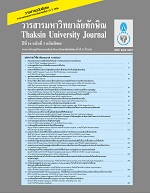คุณลักษณะการถ่ายเทความร้อนของการไหลสถานะเดียวภายในท่อตรงและท่อขดเกลียวขนาดเล็ก
Main Article Content
Abstract
งานวิจัยนี้ได้ทำการศึกษาเชิงทดลองเพื่อศึกษาคุณลักษณะการถ่ายเทความร้อนของน้ำขณะไหลผ่านท่อกลมขนาด เล็กที่ท่อเป็นท่อเส้นตรง และท่อขดเกลียว โดยที่ท่อทดสอบทำมาจากสแตนเลสซึ่งมีขนาดเส้นผ่านศูนย์กลางภายในของท่อ เท่ากับ 1.75 มิลลิเมตร ยาว 70 เซนติเมตร และที่เส้นผ่านศูนย์กลางของคอยล์ (ท่อขดเกลียว) เท่ากับ 34 48 และ 61 มิลลิเมตร ค่าสัมประสิทธิ์การถ่ายเทความร้อนของของไหลที่ไม่เปลี่ยนสถานะจะทดลองโดยใช้การให้ความร้อนแบบให้ ความร้อนโดยตรง การทดลองจะทำการทดลองโดยการปรับเปลี่ยน อัตราการไหลของน้ำ และฟลักซ์ความร้อนค่า Reynolds number จะควบคุมให้ครอบคลุมทั้งช่วงของการเปลี่ยนผ่านและช่วงการไหลแบบปั่นป่วน ในขณะที่ฟลักซ์ความร้อนอยู่ ในช่วง 30 - 70 kW/m2 จากผลการทดลองพบว่าค่าสัมประสิทธิภาพการถ่ายเทความร้อนจะมีค่าสูงขึ้นเมื่อสัดส่วนความโค้ง มีค่า มากขึ้น และเมื่อนำไปเปรียบเทียบกับค่าสหสัมพันธ์ของ Dittus-Boelter [1] Gnielinski [2] และ Petuknov [3] พบว่าไม่ สามารถทำนายได้อย่างถูกต้อง
Single-Phase Heat Transfer Characteristics in the Straight and Helical Minichannel Tubes
Santiphap Nakkaew1 Ronee Binmud2 and Jatuporn Kaew-On3*
In the present work, the single-phase heat transfer of water flowing through the straight and helical minichannesl tubes was experimentally studied. The test section was made from the stainless tube with an internal diameter of 1.75 mm and 70 cm long. The coil diameters were 34, 48, and 61 mm. The single-phase heat transfer is experimentally determined based on the direct heating operation. The experiments have been carried out by varying the water flow rates and supplying heat fluxes. The Reynolds numbers were performed covering transition to turbulent flow regimes, while the supplying heat fluxes were approximately 30 - 70 kW/m2. The result illustrates that more enhanced heat transfer increase for tubes with greater curvature ratio. Furthermore, from the comparison of the experimental results with the selected correlations Dittus-Boeltor [1] Gnielinski [2] and Petuknov [3], we found that all of correlation failed to predict.


